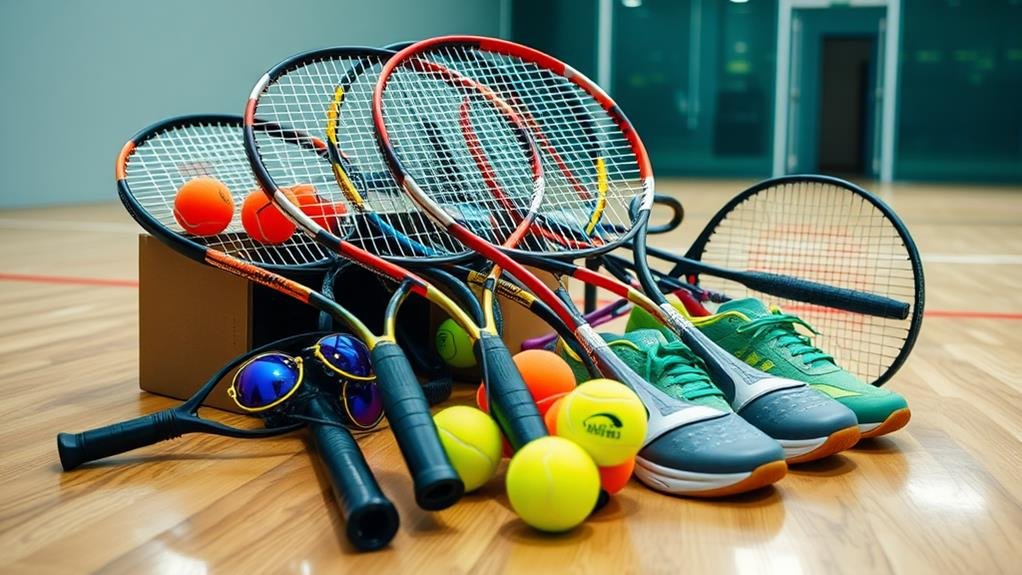Squash is an electrifying sport that tests your agility, strategy, and skill on a confined court, making it a thrilling experience for any player. Originating in 19th century England, the game has evolved with structured rules and innovative equipment. You'll learn the essential game rules, scoring systems, and techniques crucial for improvement. Understanding the various equipment, from racquets to shoes, can significantly affect your performance. With competitive leagues and notable players inspiring many, squash offers a vibrant community. If you're eager to elevate your game and grasp deeper strategies, there's a wealth of information waiting for you.
Key Takeaways
- Squash originated in early 19th century England and evolved into a structured sport with formal rules and dedicated courts.
- The game features two primary scoring methods: traditional and point-a-rally, impacting gameplay strategies and pacing.
- Essential equipment includes specialized racquets, balls, shoes, and protective gear to enhance performance and safety.
- Advanced strategies focus on tactical positioning, shot selection, and anticipating opponents' moves to gain a competitive edge.
- Notable players like Jahangir Khan and Nicol David have significantly shaped the sport's history and inspired future generations.
History of Squash

The history of squash is a fascinating journey that traces back to the early 19th century in England. You'll find the sport's origin stories rooted in the unique environment of London's prisons, where inmates played a game by hitting a ball against a wall. This innovative adaptation soon migrated to schools, where it evolved into a more structured and competitive sport.
As you delve into the evolution timeline, you'll discover that the game rapidly gained popularity. By the mid-1800s, dedicated squash courts began to emerge, and the first formal rules were established. This marked a turning point, allowing squash to transition from a casual pastime to a recognized sport.
Throughout the years, squash has continued to innovate, influenced by advances in racquet technology and court design. You'll notice how the sport has embraced inclusivity, attracting diverse players from various backgrounds.
This journey reflects not just the growth of squash as a sport but also its ability to adapt and thrive in an ever-changing world. Embrace this rich history as you explore your own squash journey, knowing you're part of a legacy that champions innovation and evolution.
Rules of the Game
Building on squash's rich history, understanding the rules of the game is key to fully enjoying and excelling in this dynamic sport. The rules might seem complex at first, but grasping the basics will enhance your gameplay and respect for game etiquette.
- Scoring Variations: Familiarize yourself with the two primary scoring methods—Traditional and Point-a-Rally. In Traditional, only the server can score points, while in Point-a-Rally, points can be scored by either player, making every rally crucial.
- Service Rules: You must serve from the designated service box and aim to hit the front wall above the service line. A successful serve sets the tone for the rally.
- Interference: Always be aware of your opponent's position. If you impede their shot, you risk a let or a stroke awarded against you. Understanding this aspect of game etiquette can prevent unnecessary disputes.
Equipment Needed

To step onto the squash court with confidence, you'll need the right equipment that enhances your performance and comfort. Start with the racquet; explore various racquet types, like lightweight or balanced options, to find what suits your style.
The ball selection is crucial too; choose the appropriate type based on your skill level and the court dimensions you're playing in.
Footwear choices can't be overlooked—opt for specialized squash shoes that provide grip and support, reducing the risk of injury. Protective gear, such as eyewear, is essential to shield against potential hazards during intense rallies.
For beginners, essential items include a basic racquet, a few balls, and comfortable clothing.
Don't forget about maintenance tips: keep your racquet clean and check for any wear to extend its lifespan.
As for equipment costs, be mindful of your budget—there are quality options available at various price points, so you won't have to break the bank to get started.
With the right gear, you'll not only feel more confident on the court but also improve your overall game experience.
Basic Techniques
Mastering the fundamentals of squash is crucial for any player looking to enhance their game. To elevate your skills, focus on these essential techniques:
- Grip Techniques: Your grip can make or break your shot accuracy. Experiment with different grips to find what feels comfortable and effective for both forehand and backhand shots.
- Footwork Drills: Quick and agile movements are vital. Incorporate footwork drills into your warm up routines to refine your speed and positioning on the court, allowing you to reach the ball efficiently.
- Shot Selection: Understanding when to use various shot types is key. Analyze your opponent's position and adjust your shot selection accordingly, whether it's a drop shot, drive, or boast.
Additionally, focus on court positioning to maintain an advantageous stance during rallies.
Explore serve variations to keep your opponent guessing, and don't underestimate the power of mental preparation and match analysis. Reflecting on your performance can reveal areas for improvement.
Advanced Strategies

Having established a solid foundation with basic techniques, you're now ready to explore advanced strategies that can elevate your squash game to the next level. One of the key elements to focus on is tactical positioning. Understanding where to place yourself on the court can create opportunities for both offense and defense.
Always aim to occupy the T-position after each shot, as this gives you the best access to respond to your opponent's next move.
Next, let's talk about shot selection. It's not just about hitting the ball; it's about choosing the right shot at the right time. Mix up your shots between drives, drops, and lobs to keep your opponent guessing.
This unpredictability can force them into making mistakes, giving you the upper hand.
Moreover, anticipate your opponent's reactions. If they favor a particular shot, position yourself accordingly to counter it effectively.
By combining tactical positioning with strategic shot selection, you can dominate the court and outmaneuver your opponent.
Training and Conditioning
How can you enhance your squash performance beyond just developing your techniques? Focusing on training and conditioning is essential for elevating your game. Incorporate a balanced approach that targets strength, endurance, and flexibility.
Here are three key components to include in your regimen:
- Strength Training: Incorporate exercises like squats and lunges to build your lower body strength, crucial for explosive movements on the court.
- Endurance Workouts: Engage in cardiovascular fitness routines, such as interval running or cycling, to boost your stamina and keep you competitive during long matches.
- Flexibility Exercises: Don't overlook the importance of flexibility. Regular stretching and mobility work will enhance your range of motion and help prevent injuries.
Additionally, pay attention to nutrition tips that support your training, such as maintaining hydration and consuming balanced meals.
Mental conditioning can't be ignored either; practicing visualization techniques can sharpen your focus.
Implement recovery strategies like foam rolling and rest days to optimize your performance.
Lastly, regular skill assessments help identify areas for improvement.
With these elements in place, you'll be well on your way to squash success!
Scoring Systems

Understanding the scoring systems in squash is crucial for players at all levels, as it directly influences your strategy and mindset during matches. The current point system used in squash is known as "Rally Scoring," which awards a point on every serve, regardless of who served. This means that every rally is significant, and you need to stay focused throughout the match.
Squash matches typically follow different formats, with the most common being best of three or best of five games. Each game is played to 11 points, and you must win by at least two points. Adapting your strategy based on the match format is vital; for instance, in a best-of-five situation, pacing yourself can be just as important as aggressive play.
Being aware of the scoring nuances can change how you approach each rally. For example, if you're trailing, you might need to take more risks to secure points quickly.
Embrace these scoring systems, and you'll find that they not only elevate your game but also enhance your enjoyment of squash as you adapt and innovate your tactics on the court.
Common Injuries
In squash, where every rally counts and the intensity can lead to high-stakes play, being aware of common injuries is important for maintaining your performance and enjoyment of the game.
Understanding these injuries can help you implement preventive measures and recovery techniques effectively.
Here are three common ailments to watch out for:
- Ankle Sprains: Often caused by quick lateral movements, ankle sprains can significantly impact your game. Proper warm-up routines and wearing appropriate safety gear can help reduce risk.
- Tennis Elbow: This overuse injury affects the elbow and is linked to repetitive swinging motions. Regular rehabilitation exercises and physical therapy can aid recovery and improve strength.
- Achilles Tendinitis: Resulting from overexertion, this condition can hinder your mobility. Focusing on recovery techniques and ensuring proper footwear can minimize its performance impact.
Staying informed through player education and injury statistics will empower you to take proactive steps.
Prioritize your health, and you'll enjoy squash for years to come, unencumbered by injury.
Notable Players

Squash boasts a rich history of remarkable players who've shaped the sport and inspired countless fans. When you think of legends like Jahangir Khan and Jansher Khan, you can't help but recognize their famous rivalries that fueled not just their careers but also the evolution of the game itself.
Their fierce competition during the 1980s and 1990s pushed the boundaries of athleticism, technique, and sportsmanship, setting a standard that players continue to aspire to today.
Another notable player is Nicol David, who dominated women's squash for nearly a decade. Her legacy is marked by her unparalleled skill and the way she paved the path for future female athletes, inspiring a generation to take up the sport.
As you delve into the world of squash, you'll discover how these players didn't just compete; they transformed the landscape of the game. Their stories intertwine with the sport's history, showcasing the impact of dedication, rivalry, and passion.
In embracing their legacies, you'll find motivation for your own squash journey, igniting your desire for innovation and excellence in every match you play.
Squash Competitions
The thrill of squash isn't just found in the personal stories of its champions; it's also evident in the competitions that showcase their talents. Whether you're a budding player or an avid fan, understanding the landscape of squash competitions can enhance your appreciation of the sport.
Here's what to explore:
- Amateur Leagues: These grassroots competitions offer a fantastic way to get involved, allowing players of all skill levels to compete and improve while fostering a sense of community.
- International Tournaments: These events attract top players globally, showcasing high-level skills and intense rivalries. Watching these matches can inspire your own play and understanding of strategy.
- Local Clubs and Youth Programs: Many clubs run competitions that not only help with player rankings but also emphasize sportsmanship values.
Plus, youth programs often provide not just coaching certifications but also funding opportunities for aspiring athletes.
Conclusion
As you step onto the court, the squash ball becomes a symbol of your journey—each rally a reflection of your growth, resilience, and passion for the game. Embrace the sweat and challenges, for they shape not just your skills but your character. With every match, you're not just playing; you're crafting a legacy. So grab your racket, let the walls echo your determination, and remember: in squash, as in life, it's the pursuit of excellence that truly counts.

